Scaphoid fracture
What is a scaphoid fracture?
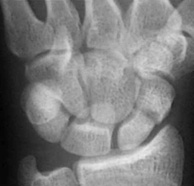 A scaphoid fracture; is a break in the scaphoid bone. The scaphoid is one of the most important bones in the wrist however it has a poor blood supply. If a scaphoid fracture is not treated properly, problems can result in the future, typically arthritis and loss of motion. The wrist is made up of eight bones (carpal bones) and arranged in two rows between the radius, ulna and the hand bones. The scaphoid is important because it spans between both of these rows of carpals, stabilising motion between the hand and the forearm.
A scaphoid fracture; is a break in the scaphoid bone. The scaphoid is one of the most important bones in the wrist however it has a poor blood supply. If a scaphoid fracture is not treated properly, problems can result in the future, typically arthritis and loss of motion. The wrist is made up of eight bones (carpal bones) and arranged in two rows between the radius, ulna and the hand bones. The scaphoid is important because it spans between both of these rows of carpals, stabilising motion between the hand and the forearm.
How do I know if I have a scaphoid fracture?
Scaphoid fractures can be mistaken for wrist sprains because they have similar symptoms. Symptoms include pain, difficulty with wrist movement and grip weakness. A most specific symptom of scaphoid fracture is tenderness over the scaphoid bone, which may be felt on the back of the hand between the tendons at the base of the thumb; (the anatomical snuff box). If the fracture is displaced a painful crunching, or moving sensation may be felt when the wrist is moved.
A scaphoid fracture is a serious problem that may be confused with a wrist sprain. Special X-rays are needed to identify scaphoid fractures; however, some fractures may not be visible on x-ray until a few weeks after the injury. So if the scaphoid is tender on examination but the x-ray shows no fracture x-rays should be repeated after 2 weeks. Rarely a bone scan, MRI or CT scan may be required.
Why did I break my scaphoid?
The most common cause of a scaphoid fracture is a fall onto an outstretched hand, which causes the wrist to hyper-extend and rotate towards the thumb. This position puts tremendous force at the scaphoid, and can cause it to bruise, crack or break into two or more pieces. Other common causes of scaphoid fracture include motor accidents, motor bike or cycling accidents and forceful blows to the wrist.
What are the non operative treatments?
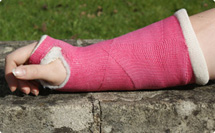 Treatment for scaphoid fractures depends on the type of fracture. Most non-displaced scaphoid fractures will heal if treated in a cast for eight weeks. The cast usually includes the thumb, wrist and forearm. At the end of this time the cast is removed, the wrist is examined and x-rays are taken. If the fracture has clinically and radiological healed the cast can stay off. If the scaphoid fracture is still there the wrist is put back in plaster for a further 4 weeks. The scaphoid can break anywhere along its length, most are at the middle bit called the waist and has an 85% healing with a plaster treatment. Reasons the scaphoid may not heal are smoking, delay in getting the wrist into plaster and fractures which are at the wrist end of the bone (proximal pole).
Treatment for scaphoid fractures depends on the type of fracture. Most non-displaced scaphoid fractures will heal if treated in a cast for eight weeks. The cast usually includes the thumb, wrist and forearm. At the end of this time the cast is removed, the wrist is examined and x-rays are taken. If the fracture has clinically and radiological healed the cast can stay off. If the scaphoid fracture is still there the wrist is put back in plaster for a further 4 weeks. The scaphoid can break anywhere along its length, most are at the middle bit called the waist and has an 85% healing with a plaster treatment. Reasons the scaphoid may not heal are smoking, delay in getting the wrist into plaster and fractures which are at the wrist end of the bone (proximal pole).
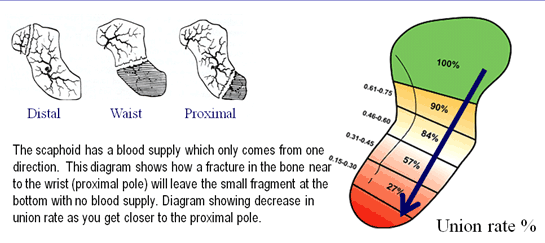
When can I return to work and driving after plaster treatment?
Return to an office job is possible within the confines of the plaster, however most insurance companies will not let you drive. Manual work will be impossible until after the cast is off and the scaphoid has healed.
What are the operative treatments?
Some scaphoid fracture patterns do not heal well with non operative treatment.
Surgery is necessary when:
- Fracture is at the very end of the scaphoid (proximal pole).
- When there is a gap between the fragments (displaced).
- When there are more than 2 fragments (comminuted).
- When the fracture line is very oblique.
- When the scaphoid has not healed in 3-6 months (see scaphoid non-union)
- Some people prefer to have their scaphoid fixed with a percutaneous technique, so they do not have to wear a plaster for 8 weeks.
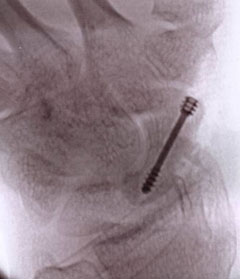 Open technique. A 3-4cm incision is made at the front or back of the wrist depending on the location of the fracture. The bone is put back together and held with a headless screw. The wound is closed with an absorbable suture. A plaster is necessary for 4- 6 weeks depending on the type of fracture. X-rays are required to check for union of the fracture at 8 weeks.
Open technique. A 3-4cm incision is made at the front or back of the wrist depending on the location of the fracture. The bone is put back together and held with a headless screw. The wound is closed with an absorbable suture. A plaster is necessary for 4- 6 weeks depending on the type of fracture. X-rays are required to check for union of the fracture at 8 weeks.
Percutaneous technique. Used for minimally displaced fractures, this technique is not suitable for all fractures. Through a 4mm stab incision and x-ray guidance a screw is passed into the bone. Because less soft tissues are cut the recovery is quicker and a plaster is only needed for 10-14 days.
What should I expect after surgery?
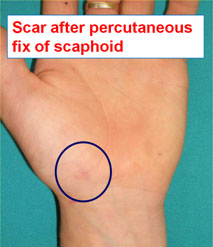 Local anaesthetic will be injected into the wound at the end of the operation. This area will remain numb for up to six hours after surgery. Before the effect wears off, you should take painkillers which should be taken on a regular basis. Swelling causes stiffness and pain which is made worse by hanging the arm down at your side or resting it on your lap. Swelling is best prevented by keeping the hand above the level of the heart for the first 48 hours. It is also important to keep the fingers moving through a full range of motion.
Local anaesthetic will be injected into the wound at the end of the operation. This area will remain numb for up to six hours after surgery. Before the effect wears off, you should take painkillers which should be taken on a regular basis. Swelling causes stiffness and pain which is made worse by hanging the arm down at your side or resting it on your lap. Swelling is best prevented by keeping the hand above the level of the heart for the first 48 hours. It is also important to keep the fingers moving through a full range of motion.
Your plaster will be removed at 2 weeks. Your stitches are absorbable so they will not need to be removed. You will then be place in a light weight cast for a further 2-4 weeks. Once the plaster is removed, it is safe to get the hand wet. The wound and the surrounding skin often become very dry and will be more comfortable if a moisturiser is applied, including on the wound itself. Initially the scar will be thickened and tender to touch. This must be massaged firmly with a moisturising cream to reduce sensitivity and swelling. You will be placed in a splint which can be removed for hand exercises.
Is there anything that can go wrong?
Operations to fix the scaphoid are very successful and most people who have them are delighted with the operation and are glad they had it done. Like any operation a very small number of people can have a problem.
- Infection can occur after any operation and would be treated by antibiotics. If the hand becomes red, hot and very swollen you must go to your GP or ring your consultant's secretary.
- Even though the surgery gives the scaphoid the best chance of healing there is about a 20% chance of the fracture failing to unite. This is more likely when there has been a long delay, you have had previous scaphoid surgery, fracture is at the proximal pole or if you smoke.
- Your fracture should unite over a 6-8 week period but it can often be 3 months before you can return to heavy manual work. The fracture can take even longer to heal and patience may be required.
- Surgery attempts to prevent the development of arthritis; however it can still occur over a 2 to 10 year period.
- The scar will be a little firm to touch and tender for 6-8 weeks, neuromas can form which small tender areas caused tiny nerves under the skin. These can be removed easily.
- You are likely to lose some movement at the wrist, although it will not restrict you in activities of daily living.
- Very rarely the hand goes into shock as a reaction to the trauma of the surgery and the hand may become swollen, painful and stiff (Complex Regional Pain Syndrome). This problem cannot be predicted. The treatment is physiotherapy and sometimes injections are necessary. It gets better on its own bur can take many months.
You should discuss the possibility of problems with your surgeon before your operation.
When can I return to driving and work after surgery?
After two weeks you can usually drive a car as long as you are comfortable and have regained full finger movements. Timing of your return to work varies with your occupation and this should be discussed with your therapist.



